How to Understand the New IPCC Report: Part 2, Extreme Events
Contrary to what you've been reading, the massive new IPCC report offers grounds for optimism on climate science and policy
This is a long post on what the new IPCC Working Group 1 report says about the detection and attribution of trends in the frequency and intensity of climate and weather extremes. I first explain this terminology of the IPCC and then I systematically go through what the report says phenomenon by phenomenon. This is a topic I’ve published widely on for over 25 years (see this short book for a recent summary).
For those readers just wanting the conclusions, let’s start there (ignoring here levels of certainty and confidence and focusing at the global scale).
These conclusions are substantially similar to those of the previous IPCC WG1 report of 2013, which is not surprising, as a few more years of data on trends observed over many decades or longer wouldn’t be expected to change detection.
These conclusions of the IPCC, and presented in the language of the IPCC below, indicate that it is simply incorrect to claim that on climate time scales the frequency or intensity of extreme weather and climate events has increased for: flooding, drought (meteorological or hydrological), tropical cyclones, winter storms, thunderstorms, tornadoes, hail, lightning or extreme winds (so, storms of any type).
Surprised?
Let’s get to the details.
Detection and Attribution
Understanding the IPCC’s latest conclusions on extreme weather and climate requires a brief introduction to some technical terminology. The IPCC has long used a two-part framework to (a) identify changes in climate, called detection, and (b) to explain why identified changes may have occurred, called attribution.
Here is how the IPCC defines detection:
Detection of change is defined as the process of demonstrating that climate or a system affected by climate has changed in some defined statistical sense, without providing a reason for that change. An identified change is detected in observations if its likelihood of occurrence by chance due to internal variability alone is determined to be small, for example, <10%.
And here is how the IPCC defines attribution:
Attribution is defined as the process of evaluating the relative contributions of multiple causal factors to a change or event with an assessment of confidence.
Let’s look at an example showing how the IPCC employs this framework, with a focus on global average surface temperatures. The figure below (3.4b) shows change global average surface temperature for several methods from 1850 to 2020.
You don’t have to be a statistician to see that temperature since 1900 has increased as compared to an earlier reference period of 1850 to 1900. This indicates a change in climate for this metric. In the vernacular of the IPCC, detection has been achieved.
Once a change in climate has been detected, the next step is to explore why. It is important to understand that just because a weather or climate variable exhibits change over climate time scales (typically 30 years or longer) does not tell us why that change has occurred.
The IPCC uses computer models to explain observed changes in global temperature. The figure below (SPM.1b) shows global average surface temperatures from computer models that are run with and without human contributions to climate. The black line shows the historical observations, as above.
You can see that the computer models run with human factors much better matches historical observations. This is one (of several) bases for the IPCC’s conclusion that the detected change in temperatures can be attributed to human factors.
OK, thanks for sticking with the introductory lesson. We can now get to the main action, and follow along with the IPCC’s use of its detection and attribution framework to summarize what the report says about weather and climate extremes.
The IPCC on Detection and Attribution of Weather and Climate Extremes
Heat Waves: “It is virtually certain that there has been increases in the intensity and duration of heat waves and in the number of heat wave days at the global scale”
Heavy precipitation: “the frequency and intensity of heavy precipitation have likely increased at the global scale over a majority of land regions with good observational coverage”
The IPCC (in its accompanying FAQ) recognizes that “heavier rainfall does not always lead to greater flooding.” This is something that we first argued more than two decades ago (here and here), and it is great to see it explicitly acknowledged in the IPCC report. To make claims about trends in flooding, one should look at trends in flooding and not precipitation. The conflation of the two is a common error.
Flooding (detection): “Confidence about peak flow trends over past decades on the global scale is low, but there are regions experiencing increases, including parts of Asia, southern South America, the northeast USA, northwestern Europe, and the Amazon, and regions experiencing decreases, including parts of the Mediterranean, Australia, Africa, and the southwestern USA.”
Flooding (attribution): “there is low confidence in the human influence on the changes in high river flows on the global scale”
Drought. The IPCC has distinguished four types of drought: hydrological, meteorological, ecological and agricultural. That means that simply saying “drought” in the context of the IPCC report is incomplete, and potentially confusing. Here is what the report says about each:
Hydrological drought: “There is still limited evidence and thus low confidence in assessing these trends at the scale of single regions, with few exceptions”
Meteorological drought: “The regional evidence on attribution for single AR6 regions generally shows low confidence for a human contribution to observed trends in meteorological droughts at regional scale, with few exceptions”
Ecological and agricultural drought: “There is medium confidence that human influence has contributed to changes in agricultural and ecological droughts and has led to an increase in the overall affected land area”
Tropical cyclones: “There is low confidence in most reported long-term (multidecadal to centennial) trends in TC frequency- or intensity-based metrics”
I do know a few things about this topic, haven published widely on tropical cyclones. The denigration of the TC “best track” dataset is bizarre. The dataset is the highest quality available on tropical cyclones around the world and widely used in research. It’d be a shame if the IPCC process were to have been used to promote certain work by denigrating the widely recognized best available data. There are other curiosities in this section as well.
But even so, the lack of overall trends in tropical cyclone frequency and intensity over climate time scales (and not just since 1980!) is pretty difficult to deny once you look at the data. While our work on US or global landfalls, showing no long-term increasing trends, did not make it into the report, the more comprehensive assessments of the World Meteorological Organization does have this information.
Winter storms: “There is low confidence in observed recent changes in the total number of extratropical cyclones over both hemispheres. There is also low confidence in past-century trends in the number and intensity of the strongest extratropical cyclones over the Northern Hemisphere…”
Thunderstorms, tornadoes, hail, lightning: “observational trends in tornadoes, hail, and lightning associated with severe convective storms are not robustly detected due to insufficient coverage of the long-term observations”
Extreme winds (between 60S and 60N): “the observed intensity of extreme winds is becoming less severe in the lower to mid-latitudes, while becoming more severe in higher latitudes poleward of 60 degrees (low confidence)”
Fire weather: “There is medium confidence that weather conditions that promote wildfires (fire weather) have become more probable in southern Europe, northern Eurasia, the US, and Australia over the last century”
That is it for Part 2. The next installment will take a close look at so-called “event attribution” — a methodology developed to support climate lawsuits as it became apparent that the IPCC’s conventional approach to detection and attribution was failing to find changes in many types of extreme events. Stay tuned!




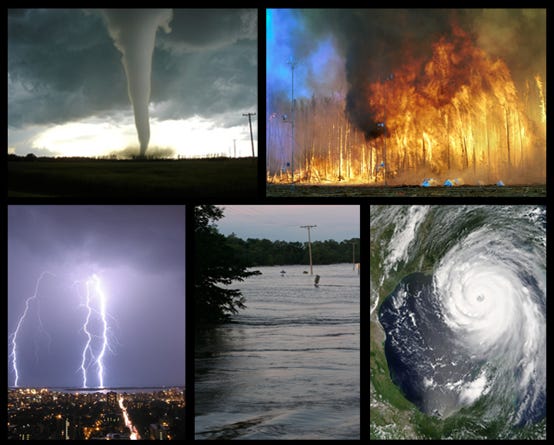
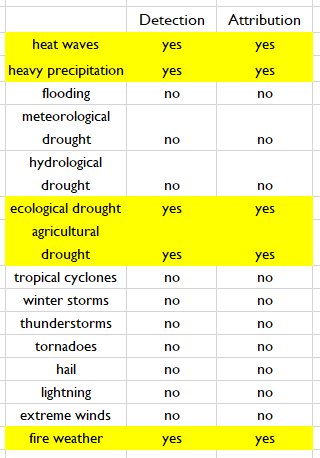
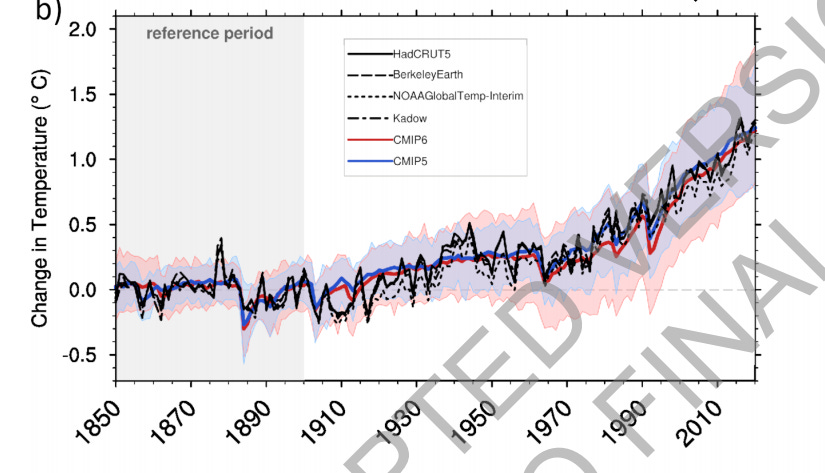
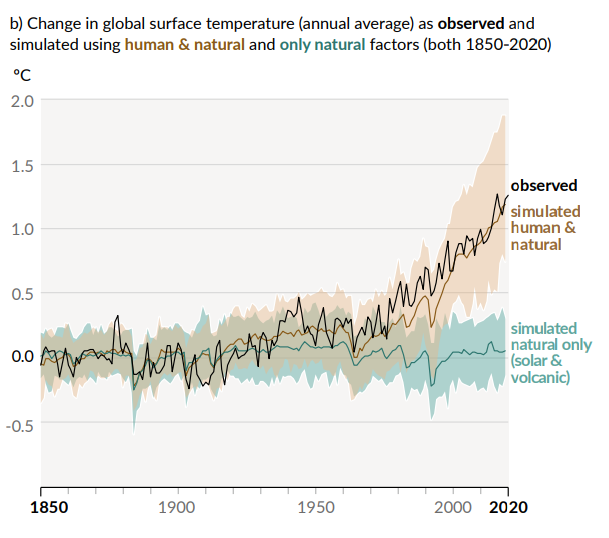


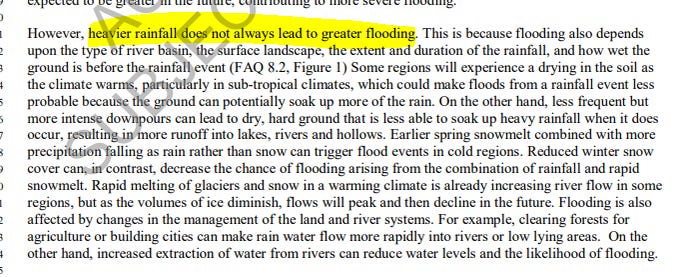







Professor Pielke, I applaud your dispassionate and evidentiary approach to scientific “controversy.” I just watched your entire interview with Nick Gillespie and must say, you are an intellectual kindred spirit! I am not a climate scientist, but a scientifically trained psychiatrist, who shares your concern about politically motivated distortions of the actual empirical evidence supporting public policy. I look forward to reading more of your reasoned thoughts about your field. Thank you.
Checking for a friend that this thread is still open to comment.